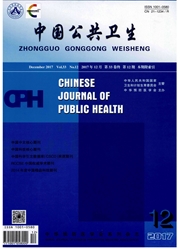

 中文摘要:
中文摘要:
目的了解2007-2009年天津农业高危人群中蜱源性立克次体感染率的变化特点。方法整群抽取天津8个区县作为调查点,每年7月至9月采样,3年共调查研究对象886例,抽取静脉血分离血清,运用间接免疫荧光方法检测人粒细胞无形体、西伯利亚立克次体及查菲埃立克体IgG抗体,分析各年感染率变化特点。结果天津市农业人群无形体感染率较高,主要分布在东部的汉沽区,2008年为52.0%;中部的东丽区2009年为70.6%,3年间总感染率增加33.3%。查菲埃立克体抗体3年总检出率为2.6%-4.4%,主要集中在中部和南部地区;西伯利亚立克次体抗体检出率最低(1.6%-2.0%),主要集中在天津中部和北部地区。结论天津地区普遍存在蜱源立克次体感染,其中以无形感染最为常见;感染率变化趋势存在地域差异。
 英文摘要:
英文摘要:
Objective To investigate the prevalence of tickborne rickettsial diseases(TBRD) and its dynamic trend in Tianjin during 2007-2009.Methods Eight districts in Tianjin were selected as study sites,and blood samples from study subjects were collected each year during July to September.A total of 886 study subjects were recruited using a cluster sampling method from 2007 to 2009.Blood samples were tested with indirect immunofluorescence assay for lgG antibodies against Anaplasma phagocytophilum,Rickettsia sibirica and Ehrlichia Chaffeensis.Results A high prevalence of human granulocytic anaplasmosis(HGA) was detected among the 8 study sites,with the highest in Dagang district(57.7%,2008) and Dongli district(70.6%,2009).The prevalence increased by 33.3 percent within the 3 years.Seroprevalence of human monocytic ehrichiosis(HME) varied from 2.6%-4.4%,and the most of the cases were detected in the center and sourth area.The prevalence of spotted fever group Rickettia(SFGR) was low(1.6%-2.0%) and more common in the center and north area of Tianjin.Conclusion TBRD,especially human granulocytic anaplasmosis,were common in Tianjin,and the prevalences showed a diverse trend in different districts.
 同期刊论文项目
同期刊论文项目
 同项目期刊论文
同项目期刊论文
 Identification of a new serotype of Rickettsia heilongjiangensis in wild rats from Guangdong Provinc
Identification of a new serotype of Rickettsia heilongjiangensis in wild rats from Guangdong Provinc 期刊信息
期刊信息
